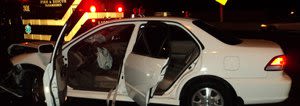
UNDERINSURED MOTORIST COVERAGE IN NEVADA FOR PASSENGERS
If you are a passenger in a vehicle involved in an accident and the driver of your vehicle is the party at fault, the driver’s liability policy limits are available to you should you have injuries or other damages. However, once the liability limits are exhausted, an underinsured motorist benefits the driver may have are not available to your as a passenger. Underinsured motorist benefits are only available to you if the driver of the other vehicle is at fault.
In Peterson v. Colonial Insurance Co., 100 Nev. 474, 686 P.2d 239 (1984), the Nevada Supreme Court concluded that cannot recover under both the liability and underinsured motorist provisions of the permissive driver at fault’s policy if liability for the accident is based entirely on the permissive driver. The case stemmed from an accident where a motorcycle passenger was attempting to recover under both the liability and underinsured motorist provisions of the policy belonging to the driver of the motorcycle. The driver of the motorcycle was determined to be solely at fault for the accident. Because Peterson, the passenger, sought recovery under both the liability and underinsured motorist provisions of the permissive driver-at-fault’s policy, the court concluded that Peterson was attempting to increase the liability coverage of the permissive driver’s policy. The court held that stacking of a liability policy on top of an underinsured motorist policy was impermissible.
The Nevada Supreme Court reaffirmed the finding in Peterson in Baker v. Criterion Insurance, 107 Nev. 25, 805 P.2d 599 (1991). In Baker, the passenger sought to recover liability and underinsured motorist benefits under her own policy and not the permissive driver’s policy. The court reaffirmed its finding in Peterson concluding that the two cases were virtually indistinguishable. The court found that whether attempting to recover the permissive driver’s policy or the passenger’s own policy, once you have recovered liability limits, you cannot recover underinsured motorist benefits under the same policy.
In Delgado v. American Family Insurance Company, an injured passenger recovered against both at-fault drivers under their liability policies and claimed that her damages exceeded the policy limits of both policies. The passenger then made a claim under the permissive driver’s underinsured motorist policy. The permissive driver’s insurance company denied the claim arguing that the passenger could not recover under both the liability policy and underinsured motorist policy of the same policy. The district court granted summary judgment in favor of the insurance company and the passenger appealed to the Nevada Supreme Court.
The court concluded that this case was distinguishable from Peterson and Baker in that Delgado involved jointly negligent drivers. The court concluded that the injured passenger could also recover under the permissive driver’s underinsured motorist policy in addition to the liability policy.
Contrary to the facts presented in Peterson and Baker, in this case, Dionicia made her underinsured motorist claim based on Dean’s concurrent negligence and the Dean vehicle being underinsured. The Delgado’s are not asserting that Mercelino’s vehicle qualified as an underinsured vehicle. This difference is substantial because the stacking prohibition set forth in Peterson and Baker is not implicated in this situation. Allowing recovery of underinsured benefits under the facts presented in this case coheres with the purpose of uninsured/underinsured motorist coverage.
In summary, a passenger may not recover both liability and underinsured motorist benefits from the same policy when the accident is based entirely on the permissive driver’s negligence. However, when there are multiple parties at fault including the permissive driver, the passenger may recover both liability and underinsured motorist benefits under the permissive driver’s policy.
